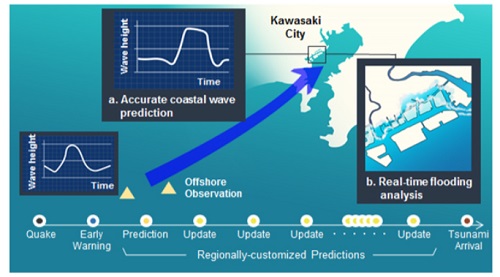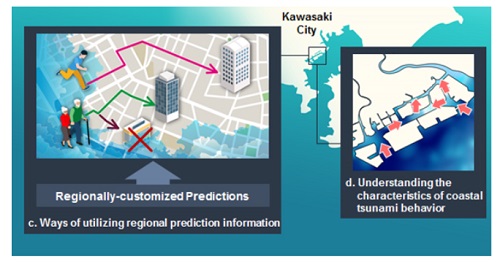|
| Friday, 24 November 2017, 10:22 HKT/SGT | |
| |  | |
Source: Fujitsu Ltd | |
|
|
|
TOKYO, Nov 24, 2017 - (JCN Newswire) - The Earthquake Research Institute at the University of Tokyo, the International Research Institute of Disaster Science (IRIDeS) at Tohoku University, the City of Kawasaki, and Fujitsu Limited have today signed a memorandum determining that they will collaborate on a project that advances the utilization of disaster prevention technologies and ICT, including artificial intelligence (AI) and supercomputers. The organizations will investigate technologies to predict tsunamis and take preemptive measures aimed at mitigating tsunami disaster risk in the Kawasaki coastal zone.
 | | Figure 1: Tsunami simulation for a major earthquake in the Nankai Trough(3) |
 | | Figure 2: Regionally customized tsunami predictions |
 | | Figure 3: Regionally customized preemptive measures for tsunamis |
The City of Kawasaki and Fujitsu signed a framework agreement aimed at promoting a sustainable community(1) in fiscal 2014, and this technology study is a part of those efforts, in collaboration with the Earthquake Research Institute and IRIDeS. In the future, the four organizations will also extend the results of this study from the coastal areas near Kawasaki to other regions, such as areas bordering the Nankai Trough, with the goal of contributing to the creation of sustainable communities that stand up well to disasters.
Details of the tsunami disaster mitigation technology study will be introduced at the inaugural World Bosai Forum International Disaster and Risk Conference 2017(2), which will be held in Sendai, Miyagi Prefecture on November 25-28, 2017.
Background
Since the Great East Japan Earthquake of 2011, Japan has rolled out infrastructure for offshore tsunami observations, and this infrastructure is being put to use to advance the development of a broad range of tsunami prediction methods. In Japan, with its diverse topographical features, there are significant differences among each region with regard to the degree of tsunami risk and level of urgency for evacuations in the case of a tsunami, and moreover, with the degree of difficulty in predicting tsunamis. For example, with a major earthquake in the Nankai Trough (figure 1), it is anticipated that there will be regions where a tsunami would hit within minutes following an earthquake, while it may take over an hour to reach Kawasaki or other parts inside Tokyo Bay. In order to more effectively implement measures to reduce disaster risk from a major tsunami that could occur in the future, a system needs to not only utilize tsunami predictions that look at the whole country, but also require regionally customized tsunami predictions that take into account the characteristics of each region.
With this in mind, these organizations have agreed to work toward the investigation of practical and effective tsunami disaster mitigation measures tailored to the characteristics and needs of each region by taking full advantage of the latest ICT, such as with AI and supercomputers, in a collaborative framework of industry, government and academia.
http://www.acnnewswire.com/topimg/Low_FujitsuTsunami112417Fig1.jpg
Figure 1: Tsunami simulation for a major earthquake in the Nankai Trough(3)
Details of the Initiative
With the Kawasaki coastal zone as an area of focus, the organizations, including the Emergency Management Office of the City of Kawasaki, are exchanging views and conducting a study of technology that will be effective where disasters occur. In light of an earthquake and tsunami threat as envisaged by the Earthquake Research Institute, the companies will utilize fast and accurate tsunami flooding simulation technology(4) jointly developed by IRIDeS and Fujitsu Laboratories Ltd., and the tsunami evacuation simulation technology that models evacuation behavior, which is advanced by IRIDeS and the Fujitsu Research Institute. The organizations plan to primarily consider the following four areas.
a. Increasing the accuracy of predictions of wave profile at the coast
The organizations will study methods for accurately predicting the profile of a tsunami hitting the Kawasaki coastal zone, including wave height and arrival time, using progressively obtained observational data from distant offshore tsunami observation stations, studying their effectiveness in light of a variety of hypothetical earthquakes (figure 2).
b. Real-time flooding analysis
The organizations will build a simulation model to analyze tsunami flooding for the Kawasaki coastal zone at high resolution in real time, based on offshore observational data (figure 2).
c. Ways of utilizing regional prediction information
The organizations will evaluate the effect of disaster mitigation gained by using the regional tsunami prediction information described in a. and b. based on a simulation that models human behavior, investigating effective methods for how to utilize this information in advance (figure 3).
d. Understanding the characteristics of coastal tsunami behavior
The organizations will work to gain a preemptive understanding of the complex behavior of a tsunami in the Kawasaki coastal zone, which has multiple man-made waterways, using simulations of a variety of possible tsunamis (figure 3).
http://www.acnnewswire.com/topimg/Low_FujitsuTsunami112417Fig2.jpg
Figure 2: Regionally customized tsunami predictions
http://www.acnnewswire.com/topimg/Low_FujitsuTsunami112417Fig3.jpg
Figure 3: Regionally customized preemptive measures for tsunamis
Future Plans
After conducting this technology study, the four organizations plan to consider issues including the uncertainty of predictions and consistency with tsunami early warning information from other organizations, with an eye towards the practical application of these technologies. Furthermore, they will contribute to the creation of effective regional disaster mitigation measures for possible future earthquakes and tsunamis by applying the results of this technology study of the Kawasaki coastal zone to other regions in the future, such as the Nankai Trough coastal region.
(1) Framework agreement aimed at promoting a sustainable community
Kawasaki City and Fujitsu Sign Framework Agreement (press release, February 19, 2014) http://www.fujitsu.com/global/about/resources/news/press-releases/2014/0219-01.html
(2) World Bosai Forum International Disaster and Risk Conference 2017
http://www.worldbosaiforum.com/english/
(3) Tsunami simulation for a major earthquake in the Nankai Trough
Data from the Cabinet Office Investigative Commission on Modeling a Major Earthquake in the Nankai Trough was used for the simulation.
(4) Tsunami flooding simulation technology
Tohoku University and Fujitsu Succeed in Real-Time Flood Analysis Using Supercomputer-Based High-Resolution Tsunami Modeling (press release, February 27, 2015) http://www.fujitsu.com/global/about/resources/news/press-releases/2015/0227-02.html
Contact:
Fujitsu Limited
Public and Investor Relations
Tel: +81-3-6252-2176
URL: www.fujitsu.com/global/news/contacts/
Topic: Press release summary
Source: Fujitsu Ltd
Sectors: Enterprise IT
http://www.acnnewswire.com
From the Asia Corporate News Network
Copyright © 2025 ACN Newswire. All rights reserved. A division of Asia Corporate News Network.
|
|
|

|
|
|
|
| Fujitsu Ltd |
| Dec 26, 2025 13:04 HKT/SGT |
|
Fujitsu Develops Fujitsu Kozuchi Physical AI 1.0 for Seamless Integration of Physical and Agentic AI |
| Dec 23, 2025 13:58 HKT/SGT |
|
Tohoku University and Fujitsu utilize Causal AI to discover superconductivity mechanism of promising new functional material |
| Dec 19, 2025 01:42 HKT/SGT |
|
Fujitsu to showcase mobility and physical AI tech at CES 2026 |
| Dec 19, 2025 01:06 HKT/SGT |
|
Kirin and Fujitsu elucidate a novel gut-brain axis mechanism of citicoline for the first time worldwide through AI-based analysis and experimental validation leveraging drug discovery DX technology |
| Dec 4, 2025 18:08 HKT/SGT |
|
Fujitsu and Scaleway partner to accelerate European sustainable transformation and data sovereignty with FUJITSU-MONAKA CPU-based AI inference |
| Dec 2, 2025 22:26 HKT/SGT |
|
Fujitsu develops new technology to support human-robot collaboration |
| Dec 2, 2025 21:55 HKT/SGT |
|
Fujitsu establishes international consortium to tackle disinformation/misinformation and new AI risks |
| Dec 1, 2025 22:04 HKT/SGT |
|
Fujitsu achieves high-precision, long-duration molecular dynamics simulation for all-solid-state battery interphases with over 100,000 atoms |
| Dec 1, 2025 21:43 HKT/SGT |
|
Fujitsu develops multi-AI agent collaboration technology to optimize supply chains, launches joint trials |
| Dec 1, 2025 21:14 HKT/SGT |
|
Fujitsu launches 'Fujitsu Accelerator Program for SPORTS' to create new value through Sports x Technology |
| More news >> |
 |
|
 |
|